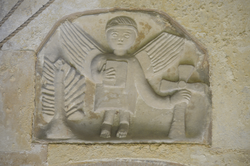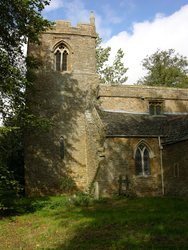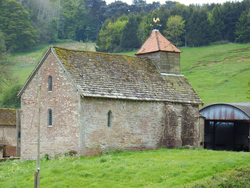
The Corpus of ROMANESQUE SCULPTURE in Britain & Ireland

Redundant former chapel
Redundant former chapel
The medieval church was completely rebuilt c.1860 but incorporates some re-used 12thc fragments, presumably from that church. It comprises a chancel, nave, N and S transepts and a S tower with spire over a porch.
Redundant former chapel
All Saints was a chapel of Rothwell until 1964, when it became redundant by 1966. It now houses the Orton Trust, founded in 1968 to teach traditional stonemasonry techniques. The nave is 12thc., with a blocked window remaining in the S wall. This now has an aisle of three bays with a 14thc. arcade. There is a 14thc. clerestorey on the S side, but not on the N where the nave is lighted by two tall windows, apparently 19thc. but with Y-tracery. The chancel is 19thc. work, but the plain chancel arch is 12thc. The unbuttressed W tower of three stepped storeys has a plain 13thc. lancet on the S wall and early-14thc. bell-openings. It was extensively restored and the chancel rebuilt in 1887. There is a 12thc. font decorated with human and animal heads.
Redundant former chapel
Yatton is a small village in the SW of the county, 6 miles NE of Ross-on-Wye. The chapel, now in the care of the Churches Conservation Trust, is in a remote farmyard ¾ mile to the W. By the 19thc the chapel was little used owing to its remoteness, and a new church dedicated to All Saints was built close to the centre of settlement. By the 1930s the chapel was in a poor state; its roof gone and replaced with corrugated iron. It was put to use as a barn until its rescue by the CCT in 1974. It is reached by a ten-minute walk down a farm track, and no vehicles are allowed. The chapel is a single cell rectangular box of coursed local sandstone rubble with a timber bell-turret with a tiled pyramid roof over the W gable. The S doorway dates it to the middle of the 12thc, but there are 13thc windows in the N, S and W walls, and the piscina is 14thc. The E wall was rebuilt in the 18thc, commemorated by a 1704 datestone and reusing 13thc windows. The church contains 2 fonts of the 12thc: the larger one brought from St Mary Magdalene, Brobury when that church was closed and partially demolished in 1873; the smaller, damaged one always here. The S doorway and both fonts are recorded here.


